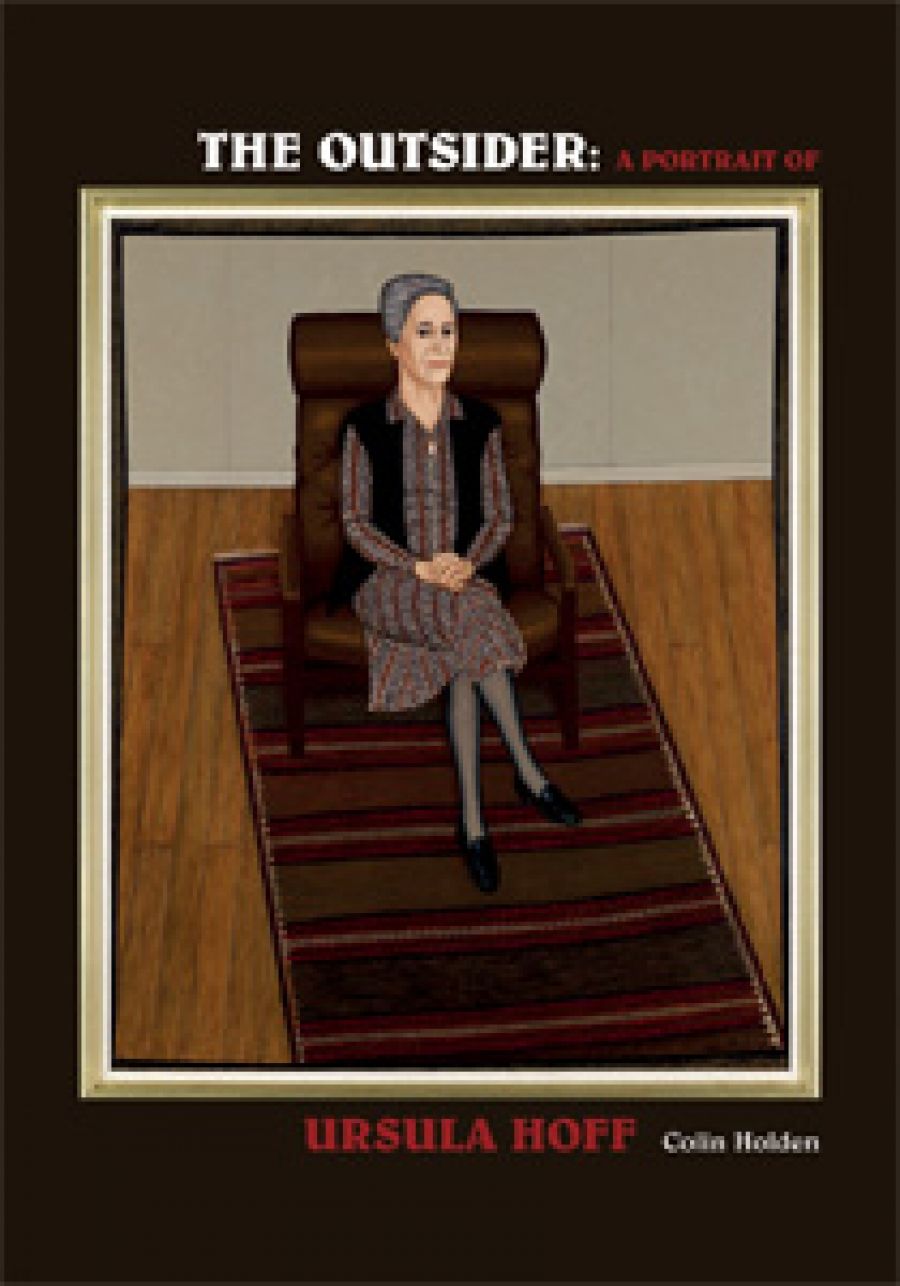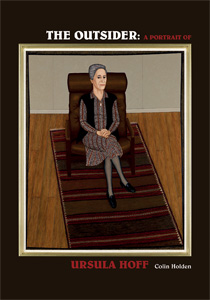
- Free Article: No
- Contents Category: Biography
- Review Article: Yes
- Article Title: Formidable Hoff
- Online Only: No
- Custom Highlight Text:
At first glance, the life of an art historian, often depressed in the latter decades of her life, might not yield a compelling book. But Colin Holden’s perusal of Ursula Hoff’s previously unknown diaries has produced a passionate and valuable portrayal of a scholar wrestling with the challenge of buying works of art for the National Gallery of Victoria, in London. The biography is based on Hoff’s diaries, still owned by her estate, and not yet in the public domain.
- Book 1 Title: The Outsider
- Book 1 Subtitle: A Portrait of Ursula Hoff
- Book 1 Biblio: Australian Scholarly Publishing, $49.95 hb, 275 pp
- Book 1 Cover Small (400 x 600):

- Book 1 Cover (800 x 1200):

Holden, an historian at the University of Melbourne, identifies closely with his subject. Before reading the diaries, he contemplated assessing them by conducting detailed interviews with Hoff’s friends and professional acquaintances, but decided against such an approach, since it had already been undertaken. As a former student and colleague of Hoff’s, I feel it was necessary to pose such questions; others have not had a chance to assess the material presented here.
The most dramatic story concerns the examination of Hoff’s doctoral dissertation in Nazi Germany in the prelude to World War II. The subject of her thesis – the critical reception of Rembrandt in England, an early example of cross-cultural art history – was seemingly inoffensive and without political ramifications. Hoff was born in London, where her father had considerable interests in the malt business, and grew up in a wealthy middle-class family. Her father was Jewish, her mother Aryan. The Hoffs lived in Germany but left Hamburg in 1933 for London. In May 1935, Hoff returned to Hamburg for the oral examination of her thesis. She had in fact returned there in mid 1934 but was forced to wait almost a year to defend her thesis before Werner Burmeister, a Nazi who wore an SA brown-shirt uniform for the occasion. It is difficult to imagine the horror caused by such intellectual intimidation and the permanent impact it made on the young art historian.
When Hoff was growing up in Hamburg, she was part of one of the most remarkable art-historical scenes of the twentieth century. Hamburg not only had a great department of art history, where the young and legendary Erwin Panofsky taught and where Hoff, as an undergraduate, must have witnessed that extraordinary transformation from formalism to iconography in the methodology of art history. Hamburg also had the first library created by Aby Warburg, an equally extraordinary figure within art history, and the first serious art historian to engage with indigenous culture. Hoff, in her teaching, was deeply committed to iconography and was one of Panofsky’s first students. A photograph (not reproduced in the volume) shows her as an elegant young woman seated next to ‘Pan’, as he was known, in the company of other legendary figures, many of them Jewish intellectuals. At the same time in Hamburg, Warburg developed his library, which in the 1930s was moved to London, first as an informal institution in South Kensington and then as part of the University of London. Warburg’s approach to art history was about the psychological understanding of Renaissance imagery, and his impact was considerable.
It is said – though not in this book – that after her move to England Hoff had difficult relations with the Warburg Institute because she claimed not to be Jewish. One can only speculate why she did this, but it was a period when everyone was under extraordinary pressure. Despite the fact that she published an early article in the Warburg Journal, she was not part of the chic inner Warburgian set. Holden does not ask the question as to why Hoff chose to come to Australia when offered the presumably not very interesting post of assistant secretary at University Women’s College rather than remaining in England, where she had positions as research assistants to a number of distinguished art historians. Deeply regrettable is Hoff’s destruction of her diaries from this period when, presumably, she analysed those legendary figures. No such material survives for any other Hamburgian. Holden does make reference in a footnote to a complex private life that she wished to eliminate from history, with a reference to Eric Hekscher, a difficult and slightly mad iconographer. Hoff had a dominating mother, from whom she may have wished to escape (her elderly mother later joined her in Australia). The photographs of Hoff, after her arrival in Australia, show her cuddling koalas and riding horseback in the bush.
Hoff’s brief at the National Gallery of Victoria was to create the department of Prints and Drawings; this was Daryl Lindsay’s initiative. Hoff’s great achievement was to create one of the most distinguished print rooms in the world. She remained in the same position at the NGV, with the exception of a brief period as deputy director. Was she disappointed, given her qualifications, that she never became a director of a major gallery? Holden does not consider this, but he does reveal Hoff had difficult relations with many of the NGV directors, especially Rowlinson, who was director during her Felton apprenticeship. He also quotes her ungenerous judgements about men in authority, even Lindsay, to whom she owed so much. In her teaching, she was capable of making observations that belittled students’ achievements, and which they remembered with irritation decades later. I suspect that Hoff was especially proud of her role as Felton Adviser (of which she was the last), which accounts for these diaries’ survival; and that she may have been frustrated by younger people’s appointments to positions for which she was never considered.
Her own collection of Australian art is most engaging. She had surprising works such as Arthur Boyd’s Bride and indigenous man, from a series made in the 1950s. Her openness to indigenous subject matter was a Warburgian characteristic. Issues about Australian racism raised in Boyd’s paintings, concerning the representation of a cross-cultural marriage, have never been adequately addressed by art historians, even in Hoff’s own monograph.
When Joseph Burke came to Australia as the first professor of art history in 1946, he went to the NGV to see what the institution had bought with what was one of the most generous bequests in the world for collecting. (The initial sum equalled the purchasing power of the British Museum and the National Gallery of London, at a time when there were unrivalled opportunities to purchase great works of art at low prices.) Burke was disappointed by what he saw.
Among the many questions posed in this book is what the NGV should collect. Should it acquire significant works that will always be on exhibition, or should it buy objects to fill gaps in the collection, as Hoff did? The history of the Felton Bequest has often been written as a series of glorious acquisitions, but there is another history to be written, about the great acquisitions that were missed, the ones that got away and that would have created a different impression on Joe Burke.


Comments powered by CComment